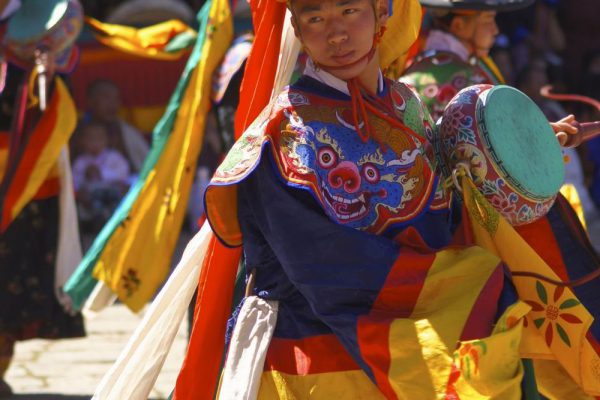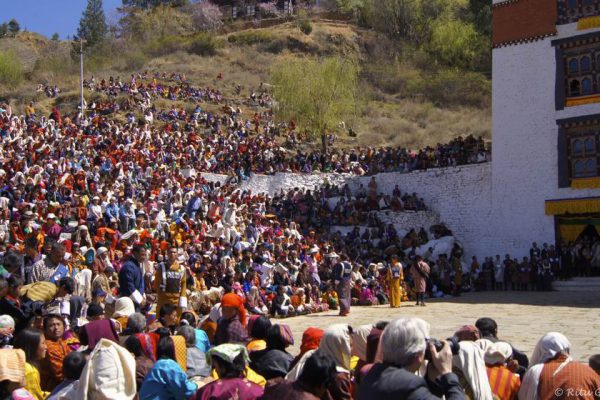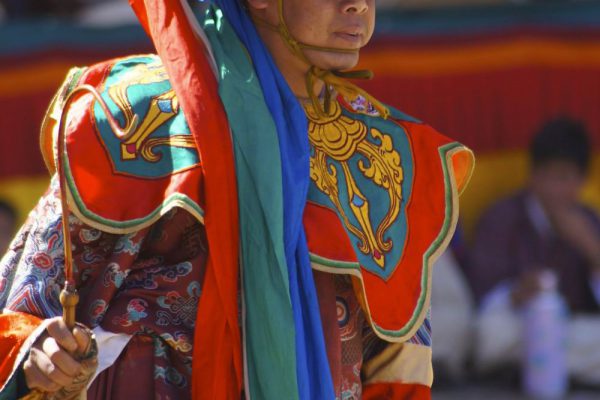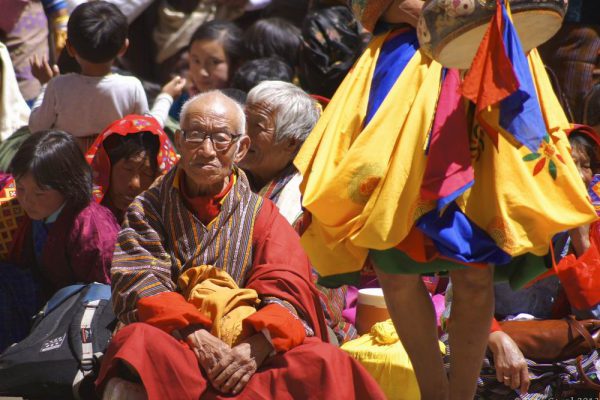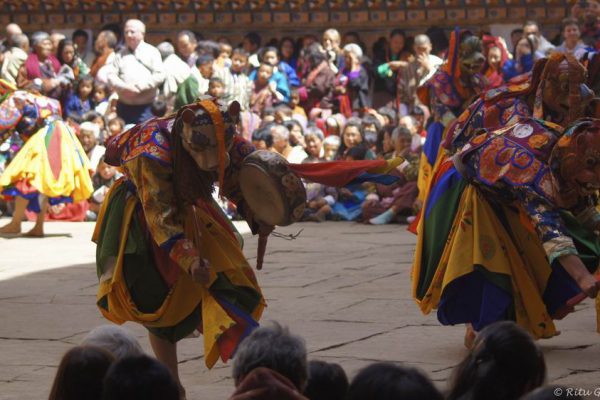
Paro Tshechu: Festival Of Delight
When we began a small online promotional exercise for this website we soon realised that amongst the “not” so popular search words (or keywords as they are called in net lingo) for Bhutan were Bhutan Culture and Bhutan Festivals.
Honestly, we were quite taken aback. Bhutan is undoubtedly a beautiful nation blessed with Nature’s bounties that offers tourists every kind of possible experience – Adventurous (treks, hikes, cycling trails, Nature walks, bird watching etc.), Historical (monasteries, fortresses, museums etc.) and Spiritual (meditation resorts, yoga retreats, spas etc.).
But perhaps one of the most important experiences is that of Bhutan’s unique culture richly showcased in its Festivals or Tshechus.
According to the Bhutan government’s tourism website, “The Tshechu is a religious event celebrated on tenth day of a month of the lunar calendar corresponding to the birthday of Guru Rinpoche (Guru Padmasambhava). However the exact month of the Tshechu varies from place to place and temple to temple.”
At a Tshechu, the Bhutanese gather together at the Dzongs (or Fortresses) where elaborate mask dances and traditional Bhutanese dances are performed. These events have deep religious and mythological significance. It is also a time when the Bhutanese socialise and the atmosphere of pomp and gaiety takes over the otherwise calm and quiet country.
The Wanderers had the wonderful opportunity to attend the Paro Tshechu, which along with the Thimpu Tshechu is one of the most significant Tshechus in Bhutan in terms of popularity.
The Bhutanese believe that everyone must attend a Tshechu and witness the mask dances at least once in order to receive blessings and wash away their sins. So we are glad we did! (Now we can sin some more ;-))
Every mask dance has a story linked to it and based on a handbook printed by a tourist organisation in Bhutan we were able to follow the dances. Most dances are based on stories and incidents from the 8th century, during the life of Guru Padmasambhava.
Paro Tshechu
The Paro Festival began on a bright spring morning in March (23rd – 27th). The first day of the festival was held inside the Dzongkhag and the second day outside the Dzong in the open.
This dance is called the Dance of the Drum from Dramitse (Dramitse Nagcham). The dancers wear a knee length yellow skirt, sport animal masks and carry a drum and drumstick.
In monasteries the mask dances are performed by monks and in remote villages they are performed jointly by monks and village men.
Legend has it that Chorten Zangmo, daughter of Pemalingpa was living in the Monastery of Dramitse in Eastern Bhutan. Her brother, the well learned Lama Kunga Gyeltshen has a vision of Guru Rinpoche and his Paradise, the Dramitse and established the tradition of the dance which depicts his vision.
Apart from the rhythmic beating of the drums that the dancers held, interspersed on regular intervals with the cymbals, these three musicians played a kind of flute.
It is believed that “Just in seeing this dance, the Black Demons are vanquished and the white Gods reign supreme. Men and Gods are happy and they gain Buddhahood, which is the ultimate objective” said the guide.
On day 2 we witnessed the Dance of the Black Hats with Drums (Shanag Nga Cham). The dances of the day were held outside the Dzong that was crowded to capacity.
The festivals begin at about 9 am (do check with your local guide for more details) and go on till evening, winding up right before sun down. In the midst of the event, there are interludes comprising of dances and jocular performances. The dances are beautiful and simple; women dressed in traditional finery move graciously to traditional music, singing along. Its the performances by the group of 3-4 clowns that keep the audience highly entertained. And that is where the duality of this otherwise conservative country lies.
We have written a post on the colourful legend of the Divine Madman whose legacy is symbolised by the phallus, depicted all over the country, on the walls of homes and establishments. The clowns wore caps that had a flying phallus on its crown and also played the fool with each other with a wooden phallus!
Since we don’t understand Bhutanese we could not follow the verbal jokes but found that the youngest of boys and girls in the audience almost fell off their seats when a clown pretended to push the wooden phallus up the other clown’s bottom!!! The clowns dragged members of the audience into their act and foreign women in the front rows were special targets, resulting in uproarious laughter from the crowd!
All in all, the festival was an extraordinary experience for us. The spectacle, the grandeur, the scale, the stories and the legends were unique to the cultural tapestry of this mighty Himalayan Kingdom. If you are planning a trip to Bhutan we would highly recommend planning it around a Tshechu. You won’t be disappointed!
Bhutan Festival Calendar
The calendar for Tshechus is available on Bhutan’s official tourism site – http://www.tourism.gov.bt/calendar
IMPORTANT
The Tshechus attract a large crowd and it is always better to reach the venue in time to find a good seating spot or a shooting spot if you’re a photography enthusiast. There are no chairs or other seating arrangements. You could carry a foldable mat or a sheet to sit on if you intend witnessing the entire show that could go on from 9 am till about 4-5 pm without real breaks.
You will find that to most locals this is a time to celebrate and the atmosphere is casual. They carry food and water as if on a picnic as there are no facilities for either in and around the Tshechu site. You could do the same.
If you are a foreign traveller (not from India or other SAARC nations) you will have a guide assigned to you by your travel operator who will take you through the legends and stories attached to each dance.
It is advisable to be dressed in full sleeved shirts and full length pants as the dress code within a Dzong is very strict. You could read our post on the architectural marvels of Bhutan, the Dzongs for more insights into acceptable dress code here: Bhutan Architecture and Slice of History – The Dzongs
The Tshechus are attended by several Bhutanese dignitaries and though the security is perfunctory, they follow a very strict code of hierarchy. When we attempted to take a few photos on day 2 we were politely but firmly asked not to “Block the view” of the dignitaries sitting in an enclosed pavilion in the vicinity. To make the best of the event, we highly recommend tripods, monopods and zoom lenses to enable a perfect capture!
Things to Remember
If you’re planning a trip that coincides with a Tshechu please make hotel bookings in advance. Also do remember that hotels will charge you more than their usual tariff due to the festival.
Travelling time to any part of the country is very high. Most of the festivals to be held this year from September – December are located in far flung districts and may need upwards of 10 – 12 hours of travelling time from Paro and Thimpu. Do plan thoroughly before you embark on a trip just for the festival. We would be delighted to help you plan a trip. Please write in to us at easeindiatravel@gmail.com with your query.
The weather becomes considerably cold by early October. You would have to pack woollens as most Tshechus are held in the open and it tends to get windy in the evenings.
We shot several videos at the festival but leave you with a short clip that shows the dancers’ entry on Day 1, for the third dance.
Ritu@2017 August 23, 2013


